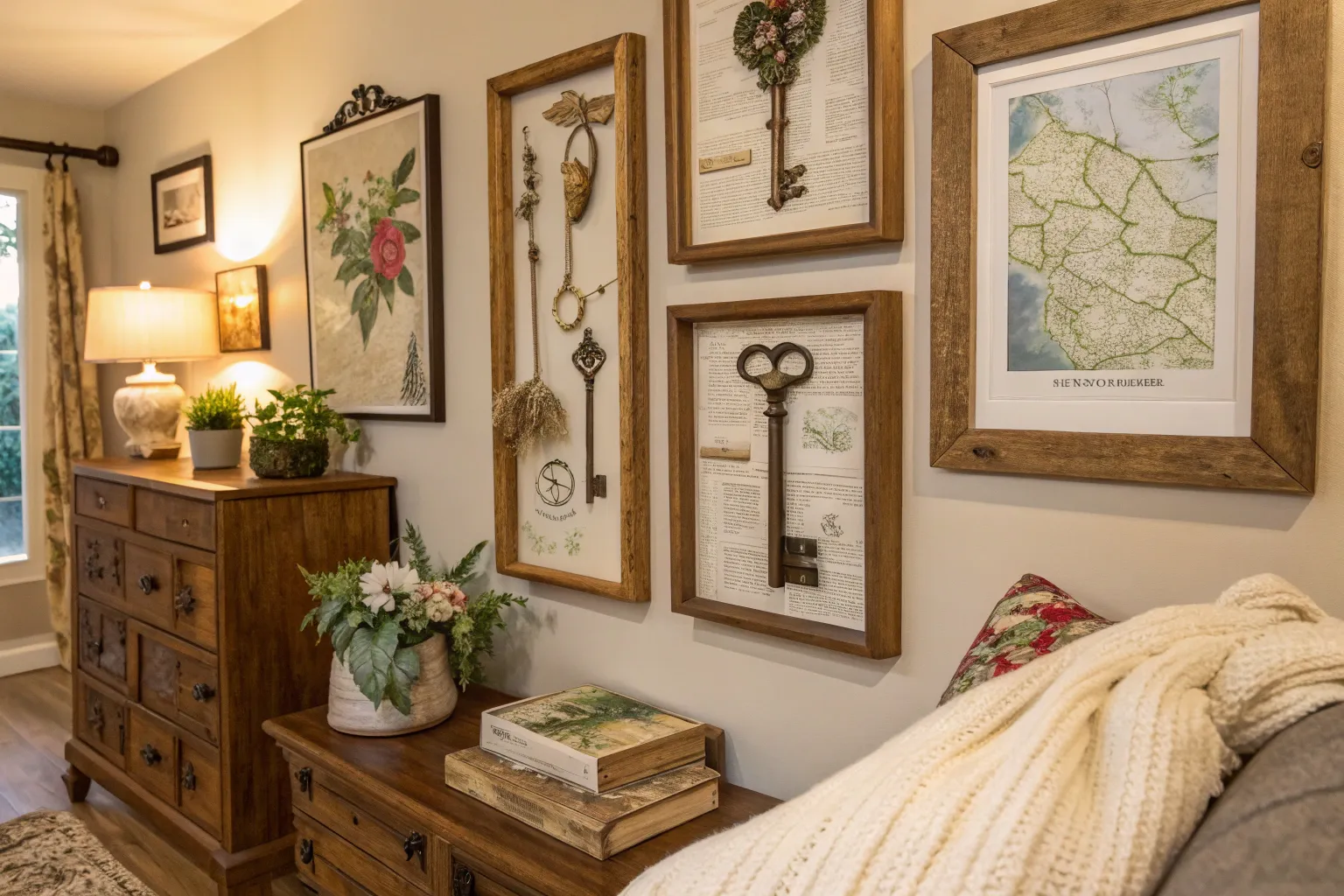Transforming everyday discoveries into meaningful displays creates an intimate connection between nature, memory, and home—one that extends far beyond traditional wall art.
The Art of Storytelling Through Objects
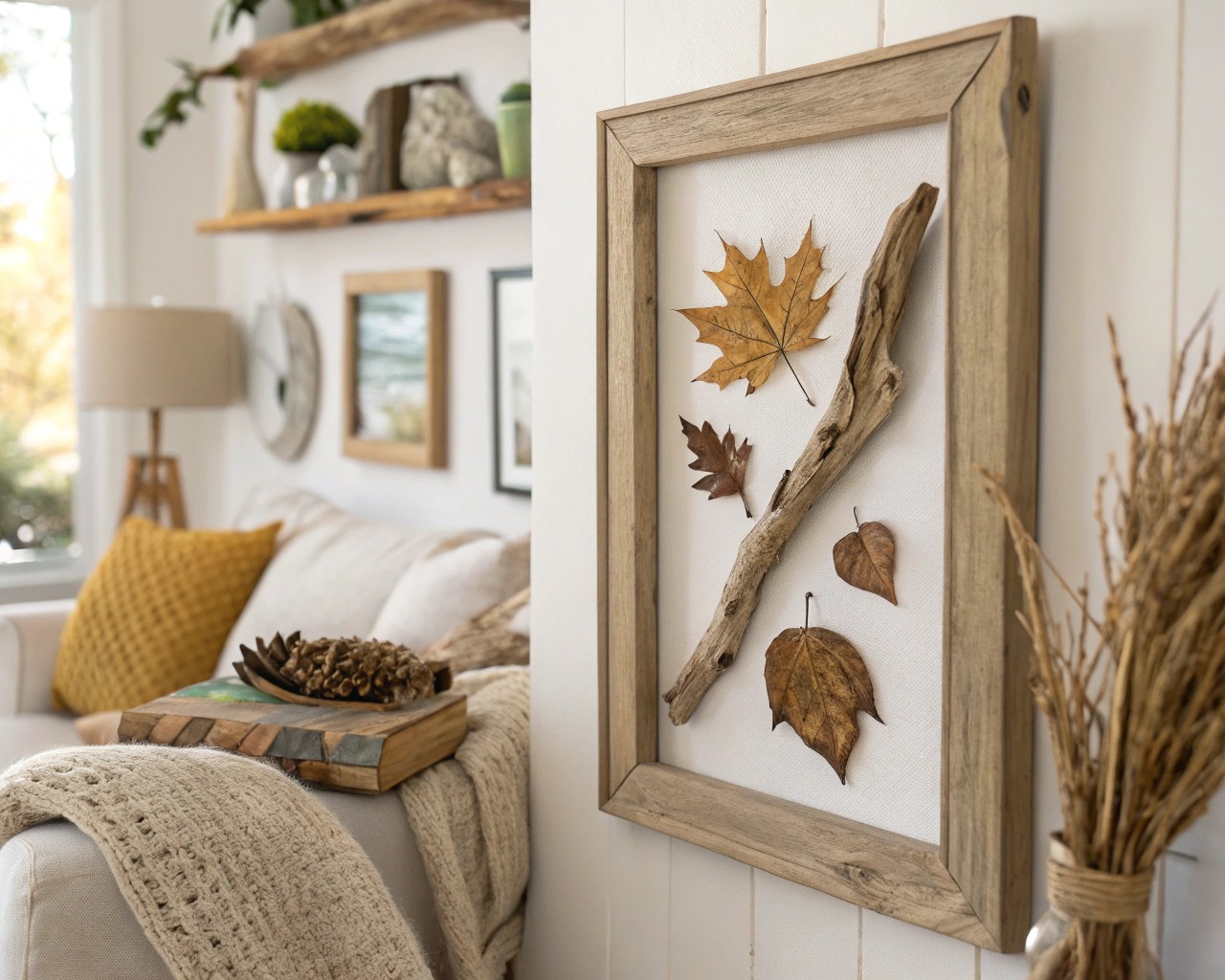
Found objects carry stories that speak to our deepest connections with place and time. As designers, we understand that the most compelling interiors emerge when personal narrative intersects with thoughtful presentation. When you frame a weathered piece of driftwood from your morning beach walk or a pressed leaf, you’re not simply creating wall art—you’re preserving a moment and inviting it to become part of your daily visual landscape.
The key lies in recognizing that every found object has inherent design potential. That smooth river stone, the delicate skeleton of a fallen leaf, or the interesting seed pod from your backyard can become the focal point of a room when properly displayed. The frame becomes the bridge between the natural world and your cultivated interior space.
Shadow Box Fundamentals: Creating Depth and Dimension
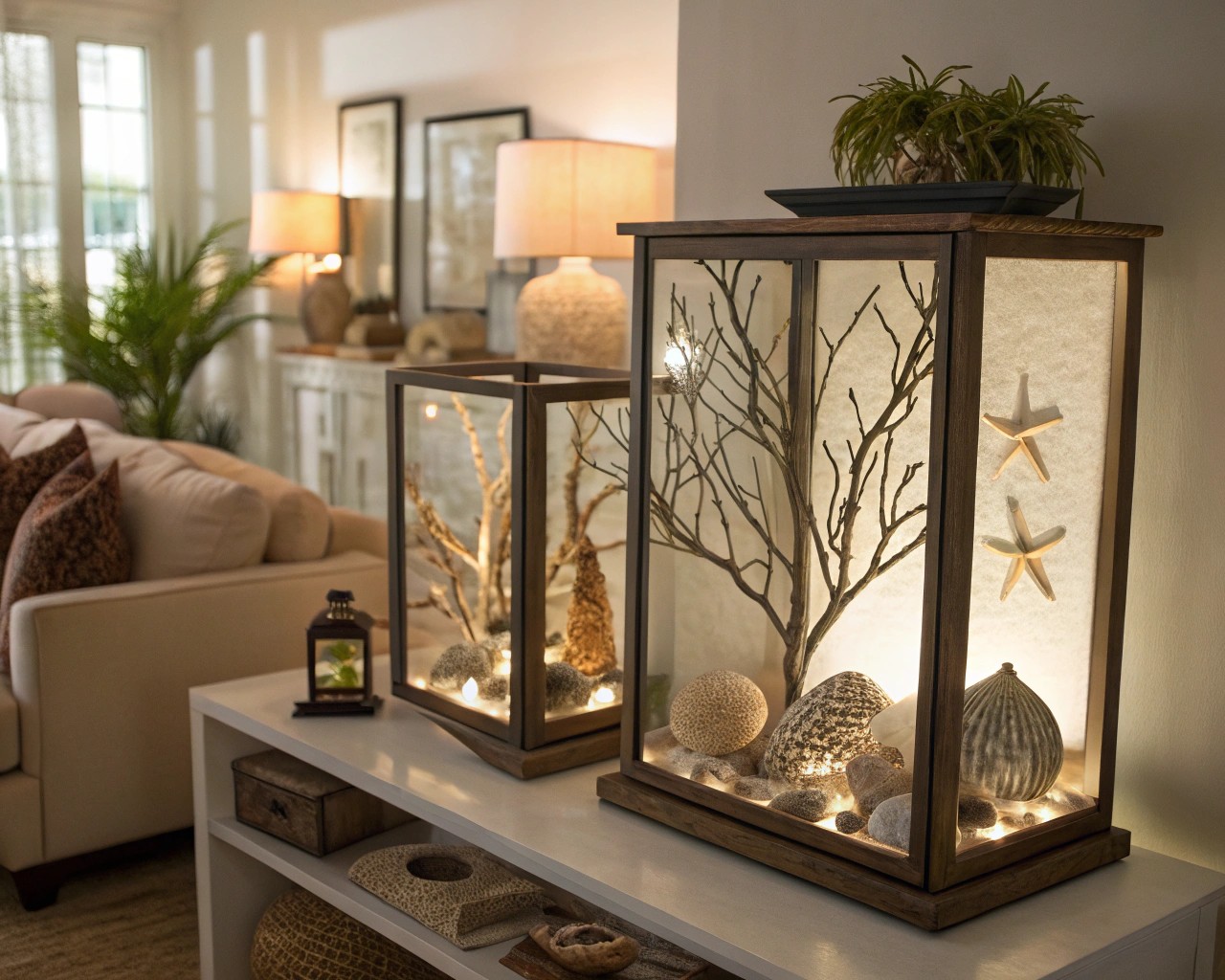
Modern shadow box framing elevates found objects by providing the essential depth needed to showcase three-dimensional pieces. Unlike traditional flat frames, shadow boxes create what I call “viewing windows”—spaces that allow objects to breathe while maintaining visual hierarchy.
Essential Shadow Box Components:
- Frame depth: Typically 1.5 to 4 inches, depending on object size
- Backing material: Acid-free mounting board in neutral tones
- Glazing: UV-protective glass or acrylic
- Mounting system: Reversible attachment methods
The depth creates natural shadows that enhance the object’s form, while proper glazing protects against environmental damage. I’ve found that positioning objects at varying depths within the frame creates dynamic visual interest—place some elements close to the glass and others deeper in the box for layered storytelling.
Professional Display Techniques
Mounting Without Permanent Damage
One of the most critical aspects of framing found objects is preserving their integrity. I always recommend reversible mounting techniques that allow future repositioning without damage.
Effective Mounting Methods:
- Invisible thread suspension: Nearly transparent fishing line creates floating effects
- Museum wax: Repositionable adhesive for lightweight objects
- Custom foam supports: Cut to cradle oddly shaped items
- Wire armatures: Hidden supports for delicate specimens
For heavier objects, create custom supports using acid-free foam board cut to the exact contours of your piece. This method distributes weight evenly while maintaining the object’s natural position.
Background Selection and Color Theory
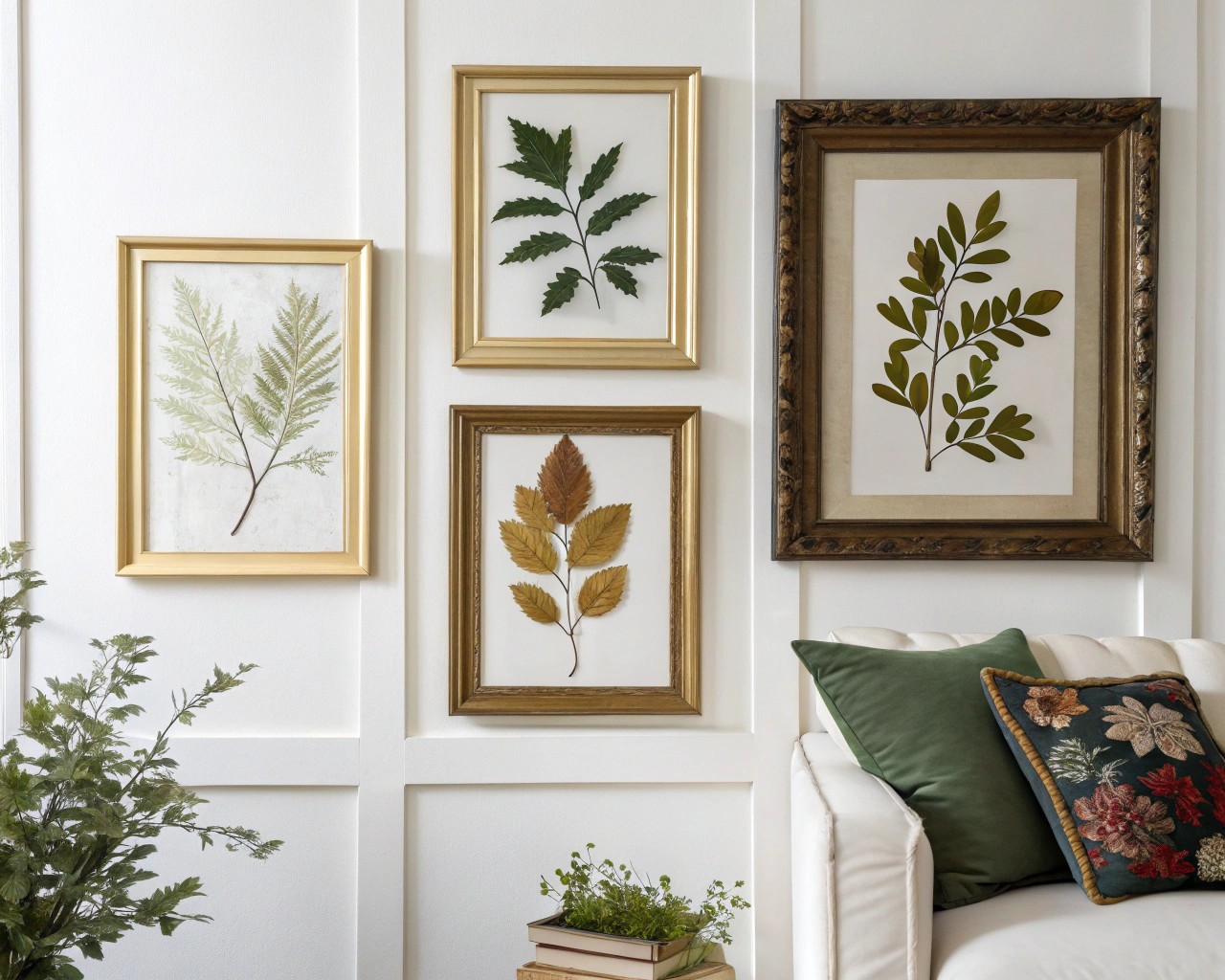
The background sets the emotional tone for your display. Neutral backgrounds—soft grays, warm whites, or natural linen textures—allow the object to command attention. However, strategic color choices can enhance storytelling:
- Deep charcoal backgrounds create dramatic contrast for light-colored objects like shells or pale stones
- Soft sage or dusty blue complements natural materials while adding subtle sophistication
- Rich burgundy or deep forest green works beautifully for vintage finds or autumn specimens
Consider the room’s existing palette when selecting background colors. The framed piece should feel intentionally integrated rather than accidentally placed.
Natural Materials and Seasonal Collections
Working with Organic Elements
Natural materials require special consideration due to their inherent instability. Proper preparation ensures longevity while maintaining authenticity:
Preparation Steps:
1. Clean gently with soft brushes to remove debris
2. Allow complete drying for several days in low humidity
3. Apply conservation spray for delicate materials like leaves or flowers
4. Monitor for pest activity before sealing in frames
For pressed botanicals, sandwich between acid-free tissue paper before mounting. This prevents direct contact with adhesives while maintaining the specimen’s natural color and form.
Creating Seasonal Rotations
I encourage clients to develop seasonal display systems that reflect the changing natural world. Spring collections might feature delicate cherry blossoms or early wildflowers, while autumn displays showcase colorful leaves and interesting seed pods. This approach keeps your interior feeling fresh and connected to natural rhythms.
Consider creating a series of identical frames that can house rotating seasonal collections. This maintains visual consistency while allowing content to evolve throughout the year.
Advanced Composition Techniques
The Rule of Asymmetrical Balance
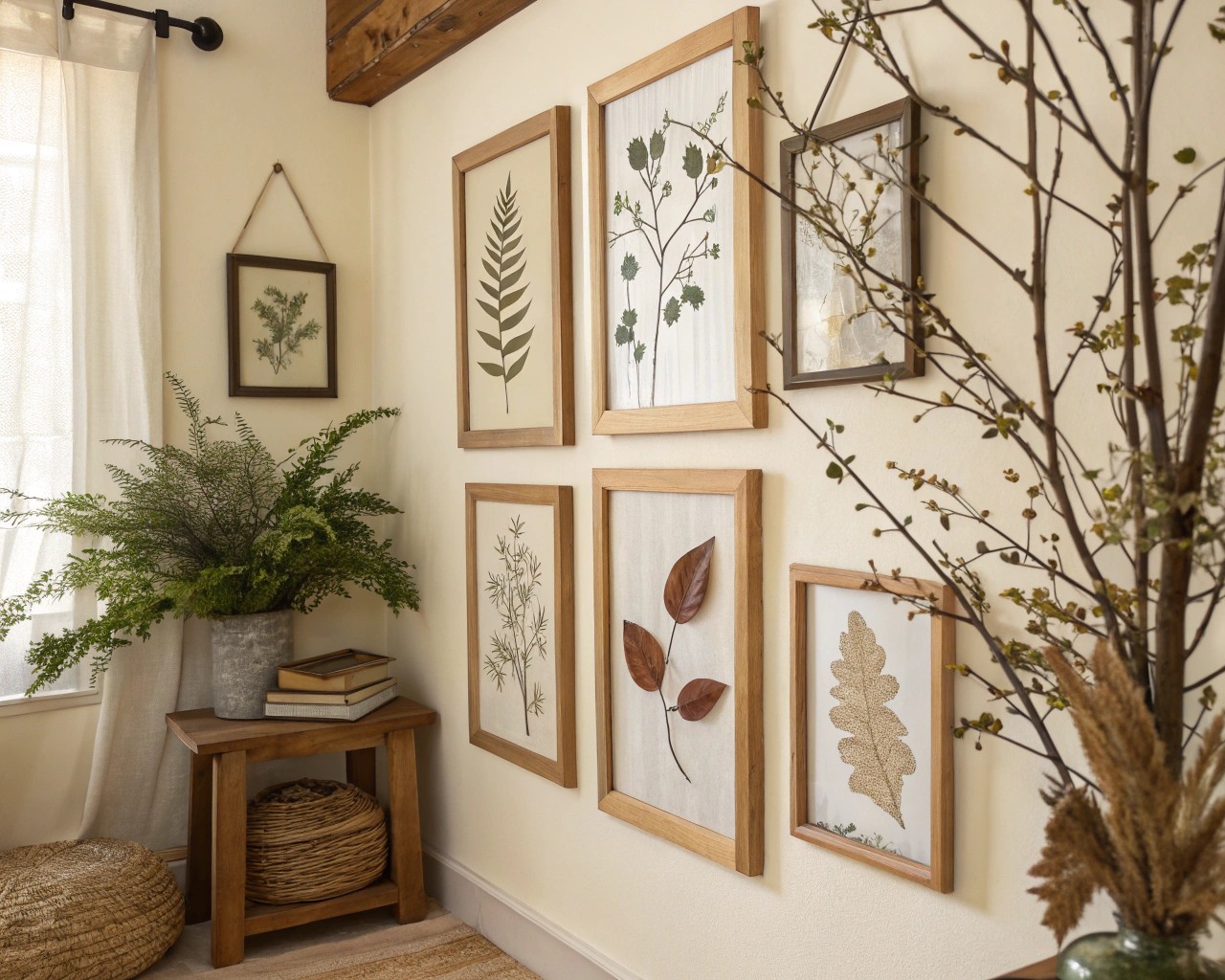
Professional display design relies on visual weight distribution rather than symmetrical placement. Position your primary object slightly off-center, then balance with smaller supporting elements. This creates dynamic tension that draws the eye and maintains interest.
Composition Guidelines:
- Primary focal point: Largest or most interesting object, positioned in upper third
- Secondary elements: Smaller supporting pieces that echo colors or textures
- Negative space: Intentional empty areas that allow the eye to rest
Layering for Depth
Create sophisticated displays by layering objects at different depths. Mount some elements directly against the background while suspending others closer to the glass. This technique mimics how we experience the natural world—with foreground, middle ground, and background elements creating spatial depth.
For example, mount a pressed fern flat against the backing, place a small stone on a hidden pedestal in the middle ground, and suspend a delicate feather near the front glass. This creates a miniature landscape within your frame.
Technical Installation and Lighting
Proper Hanging and Placement
Shadow boxes require more robust hanging systems than traditional frames due to their increased weight and depth. For frames larger than 16 x 20 inches, use two mounting points spaced at least half the frame width apart.
Professional Hanging Tips:
- Mount at 57-60 inches to center from floor level
- Use appropriate wall anchors for your wall type
- Consider the viewing angle—shadow boxes benefit from slight forward tilting to minimize glare
- Group multiple pieces with consistent spacing (typically 2-4 inches between frames)
Lighting Considerations
Proper lighting transforms framed objects from simple displays into compelling focal points. Avoid direct sunlight, which can fade natural materials and create excessive heat buildup within the frame.
Optimal Lighting Solutions:
- Picture lights mounted above the frame
- Track lighting with adjustable spots
- Wall sconces positioned to eliminate shadows
- Natural light from north-facing windows (indirect)
LED lighting provides excellent color rendering while generating minimal heat—crucial for preserving organic materials.
Storytelling Through Arrangement
Creating Narrative Groupings
The most compelling displays tell stories through thoughtful arrangement. Rather than randomly placing objects, consider their relationships and the narrative you want to create:
Thematic Approaches:
- Geographic collections: Objects from specific places or travels
- Temporal arrangements: Items representing different seasons or life stages
- Color progressions: Objects arranged by subtle color variations
- Textural contrasts: Combining rough and smooth, delicate and substantial
I often work with clients to create memory maps—groupings that trace significant journeys or experiences through carefully curated objects. A frame might include sand from a first date beach, a leaf from the tree where a couple got engaged, and a stone from their honeymoon destination.
Multi-Frame Installations
For extensive collections, consider creating gallery walls that can grow and evolve over time. Start with a core group of 3-5 frames and add pieces as your collection develops. Maintain visual cohesion through:
- Consistent frame styles and finishes
- Unified matting or background colors
- Balanced scale relationships between pieces
- Intentional spacing that creates breathing room
Maintenance and Long-Term Care
Preserving Your Displays
Framed natural objects require minimal but consistent care. Dust frames monthly with soft, dry cloths, avoiding glass cleaners that might seep into seals. Check annually for signs of pest activity or material degradation.
For valuable or irreplaceable items, maintain documentation including photographs and collection details. This serves both insurance purposes and helps track any changes over time.
Evolution and Refreshing
Part of the beauty of found object displays lies in their ability to evolve. Don’t be afraid to refresh arrangements or retire pieces that no longer speak to you. This natural evolution keeps your displays feeling current and personally meaningful.
Consider establishing an archive system for pieces you’re not currently displaying—shallow drawers or museum-quality storage boxes allow you to rotate collections and rediscover forgotten treasures.
Room-Specific Considerations
Bathroom and Kitchen Displays
High-humidity environments require special attention. Choose sealed frames with moisture barriers and avoid organic materials that might develop mold. In these spaces, focus on non-organic found objects like interesting stones, shells, or small ceramic pieces.
Bedroom Sanctuaries

Bedrooms benefit from softer, more personal displays that promote tranquility. Consider pressing flowers from meaningful bouquets or framing smooth stones collected during peaceful walks. These intimate objects create a sense of personal sanctuary within the room.
Living Areas
Public spaces can accommodate bolder, more conversation-starting pieces. Larger objects, unusual finds, or collections that span multiple frames work well in these environments where guests can appreciate and discuss your displays.
Budget-Friendly Solutions
DIY Frame Modifications
Transform standard frames into shadow boxes by adding spacer strips between the frame and backing. Cut strips of wood or foam board to your desired depth, creating an instant shadow box at a fraction of custom framing costs.
DIY Materials:
- Standard frames from discount retailers
- Foam board or wood strips for spacers
- Acid-free backing paper for conservation mounting
- Museum wax or clear thread for object attachment
Repurposing and Upcycling
Look for interesting containers that can serve as ready-made display cases. Old jewelry boxes, vintage specimen cases, or even clear food containers can be transformed into compelling displays with minimal investment.
The key to successful DIY framing lies in attention to proportions and finishing details. Take time to ensure clean edges, proper alignment, and quality materials that will protect your objects over time.
Creating meaningful displays from found objects connects us to the natural world while adding deeply personal elements to our living spaces. Through thoughtful selection, professional presentation techniques, and careful attention to storytelling, these humble discoveries become powerful design elements that speak to both our aesthetic sensibilities and our emotional connections to place and memory.
The most successful found object displays balance technical skill with personal narrative, creating windows into our experiences that enrich our daily environment and invite deeper contemplation of the natural world around us.

